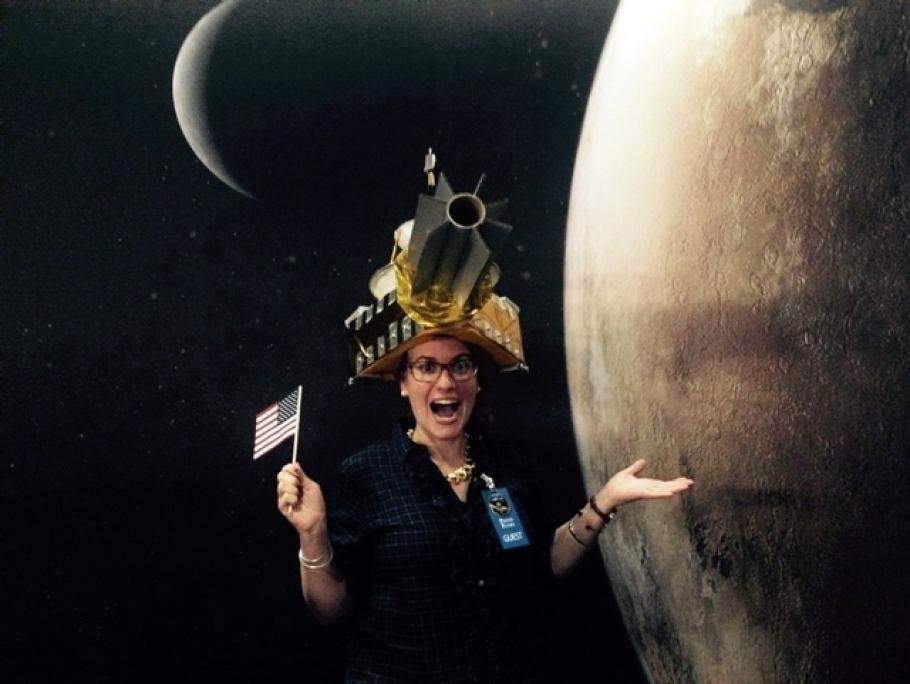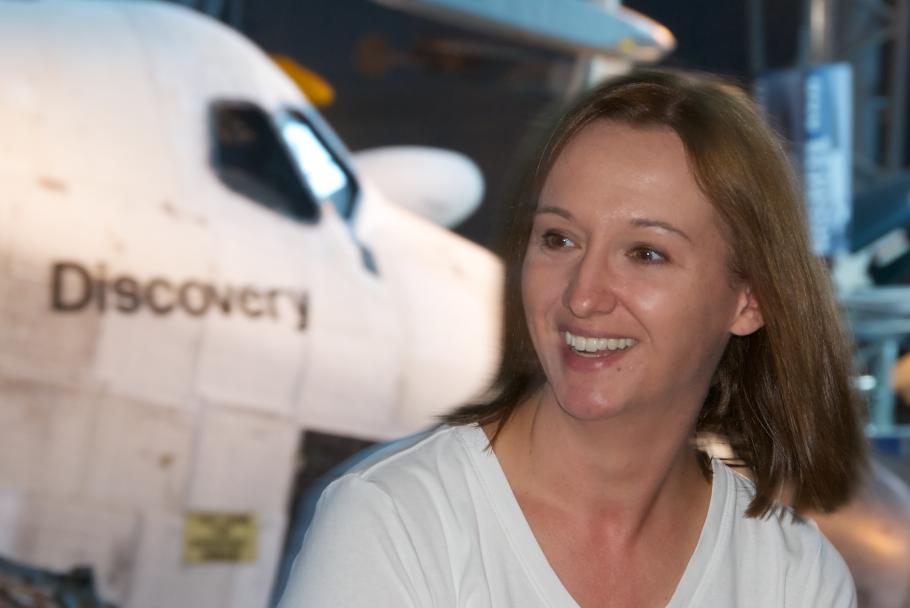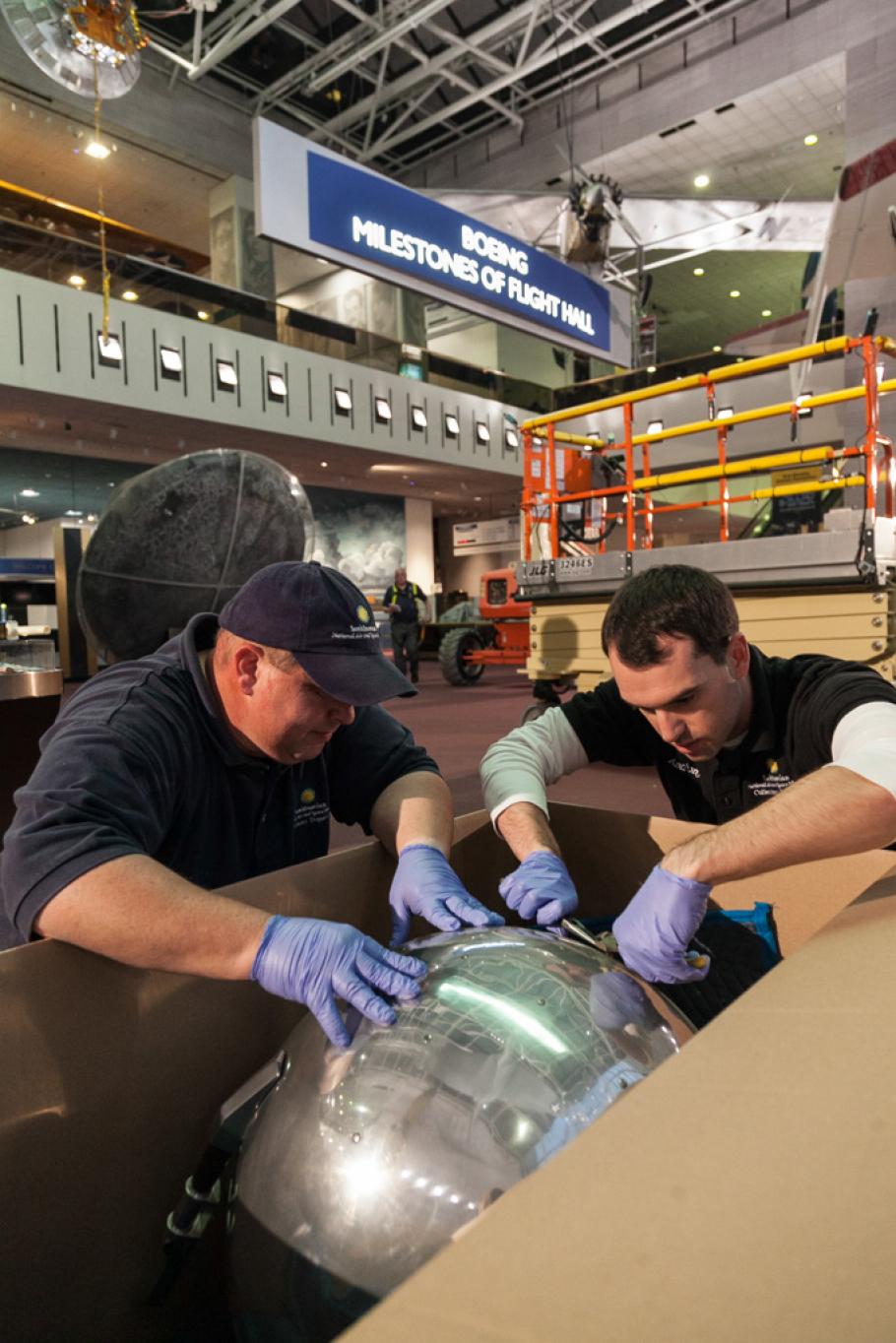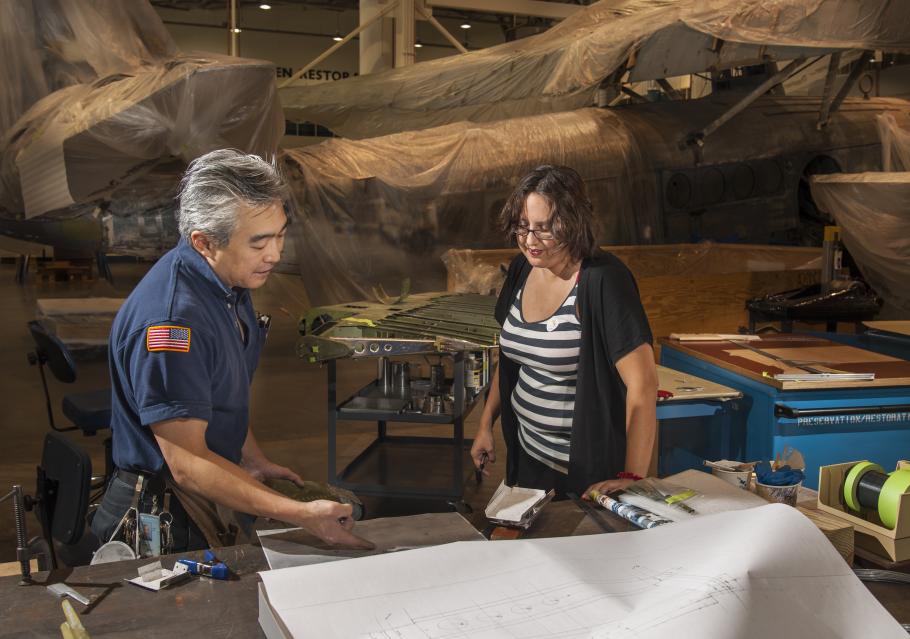Tomorrow is Ask a Curator Day. From 8:00 am to 4:00 pm take to Twitter and ask us your most burning questions—include @airandspace and #AskACurator in your tweet. We’ll have curators, researchers, archivists, and museum specialists ready to answer your questions. What’s our favorite object? How do we move airplanes? What are we researching? We have answers.
To whet your appetite for insider information, we asked our team to answer a few questions in advance to give you a taste of the diverse activities and careers that exist within our Museum.
Emily Martin
Emily is a postdoctoral fellow in the Center for Earth and Planetary Studies. She’s into exploring the ancient tectonic history of Saturn’s moon Enceladus. She also likes to research planetary surface processes and tectonic deformation of icy bodies of the outer solar system.
What path lead you to your current position?
I began a research project with a college professor who needed someone to collect some data for him. It was a really small department so it wasn't unusual to just jump into a seemingly random project for a few weeks. It seemed like a pretty great thing to explore strange new worlds all day and look at pictures taken by robots. I decided I wanted to do more of it, and so, it made the most sense to pursue graduate studies. When I graduated, I came here to the National Air and Space museum for my post-doctoral fellowship.
What is the most unbelievable, can’t-believe-it-happened story from your time here at the Museum?
I was asked to interview an astronaut for one of our programs here at the museum called What's New in Aerospace. I've never interviewed anyone before, let-alone in front of a live audience. It was especially cool because the astronaut was Christina Koch who is a part of the new generation of astronauts preparing to travel to locations other than the International Space Station. Getting to talk to her about all of the intense and diverse training was really fun. She is someone who is also really interested in exploring new places like me, but she does it in a really different (and extremely awesome) way.
What would surprise people about what you do?
I don't use telescopes. You can do really interesting planetary science with ground-based telescopes, and you can even do planetary science on bodies that are really far away, like Pluto. But the types of questions I work to answer require high-resolution images of the surface of a planetary body which can only be achieved through images taken by a robotic spacecraft.
If someone were interested in pursuing a similar career what advice would you give them?
Take a chance on yourself and be a little flexible. I was a physics major in college with a minor in astronomy. Upon declaring my major (at the very last minute!), I still was very uncertain about what I wanted to pursue as a career. It occurred to me that there was actually nothing stopping me from trying to become an astronomer. I thought space was pretty cool. I pursued an internship through the Research Experiences for Undergraduates program through the National Science Foundation and worked at the Lowell Observatory in Flagstaff, Arizona (where Pluto was discovered!). I learned a lot that summer and had an amazingly positive experience. I learned a lot about doing science and gained many valuable skills that I still use today in my research. But I also learned that I didn't actually enjoy DOING astronomy, and that's what lead me to planetary science. Lots of doors will always be opening (and sometimes you'll have to push some of them open), but you have to be willing to walk through them, even if they don't look exactly how you expected. Careers aren't always built along linear paths.
Jennifer Levasseur
Jennifer is a curator with the Museum’s Space History Department. Under her expert care is the Museum’s collection of astronaut cameras, Skylab program materials, and astronaut personal equipment (pre-shuttle). She also lends her talents to public programs like new exhibitions and lectures.
What path lead you to your current position?
I worked from the ground up to become a curator. I’m a practical person and didn’t want to just go all the way through school from undergrad through PhD, and wanted to earn a living for a while. So, I got a job at the Museum after finishing my MA and then just plugged away at work, and eventually that PhD too, with things finally landing on a true curator job earlier this year.
What is the most unbelievable, can’t believe it happened story from your time here at the Museum?
Most of my “I can’t believe it” stories come from meeting or seeing notable people who come through the Museum. The craziest is the morning Michael Jackson toured the building with two of his children, probably back in 2007 or 2008. I saw him from the second floor going down the escalator, and while it was exactly the experience I expected – the secrecy, the entourage, the chaos – my jaw still drops to think of it.
What would surprise people about what you do?
In reality it’s probably how much time we spend on administrative tasks like arranging travel or filling out paperwork. It’s not always meeting astronauts or exploring historic artifacts!
If someone were interested in pursuing a similar career what advice would you give them?
I tell anyone thinking of being a curator to consider what kind of education they want to be involved in. As curators, we primarily do research, followed by exhibitions, public programming, and collections work. The research is very formal while the other two have an informal educational impact. You have to be interested in balancing those. It’s not like being a professor or teacher. But it has some very cool elements that I really enjoy and give me a taste of many different ways that I can reach people with what I enjoy and find interesting about history.
Anthony Wallace
Anthony is a supervisory museum specialist working in the Museum’s Collections Processing Unit. His calm and collected demeanor is perfect for a person responsible for moving some of the Museum’s largest and most complicated artifacts. Anthony organizes the movement of the Museum’s tiniest artifacts to its largest.
What path lead you to your current position?
I was a history major in college interested in military history and aviation. I wanted to do something other than teach. I applied for an internship with Museum while I was still in school and spent one semester working in the Aeronautics Department. I interned two more times in the Collections Department and officially moved to Washington, DC for graduate school after college. I graduated with an MA in Museum Studies and was hired with the Collections Processing Unit. I have been with the Unit for the last eight years and became a Supervisory Museum Specialist a little over two years ago.
What is the most unbelievable, can’t-believe-it-happened, story from your time here at the Museum?
I worked on the crew that hung a U.S. Coast Guard helicopter at the Steven F. Udvar-Hazy Center the week before I was activated for a 14-week training period with the U.S. Coast Guard (USCG). Normally my work with the Coast Guard and the Museum do not intersect, but this project allowed me to do something for both at the same time.
What would surprise people about what you do?
People would be surprised that I am a tractor-trailer driver as well as a crane and forklift operator. We have a lot of large objects in our collection that we need to be able to handle. They require large pieces of equipment.
We also have a large number of objects in storage, including a very large art collection. The public sees only a fraction of our collection when they visit our Museum.
If someone were interested in pursuing a similar career, what advice would you give them?
Keep all of your options open and find something that makes you stand out from everyone else. The Museum Studies field is growing with more graduates every year. Try to learn about all aspects of your chosen career so you are not limited to only one specific area. Once you get to work in a museum you can learn from others and find potential openings in your desired field.
Elizabeth Borja
Elizabeth serves as the reference and outreach coordinator for the National Air and Space Museum Archives. Her jam is finding the answer to hard questions and digging up archival records that give her an excuse to talk about holidays and sports.
What path lead you to your current position?
You could say that I became an archivist by accident. During my senior year of undergraduate school, I applied for a position shelving books in the university library. Fortunately, my application was picked up by the Broadcasting Archives. I started out processing a collection from the Corporation for Public Broadcasting (think Sesame Street) and thought, “these are my people.” And the rest, as they say, is history. I went on to earn a MA in Archives and Records Management as well as History. I enjoy working with people, so this fits very well with my position as reference and outreach coordinator for the Archives.
What is the most unbelievable, can’t-believe-it-happened story from your time here at the Museum?
I have been asked to identify photos of UFOs. I was given the date, time, and location of the photographs. To solve the mystery, I checked the weather history for that day. It had been raining. The odd shapes on the print were water spots on the camera lens. Unidentified objects identified!
What would surprise people about what you do?
No day is the same for a reference archivist. Though we receive the same type of questions frequently, there are usually no repeat questions. If researchers are asking about the history of an aircraft, it is frequently because they own that aircraft or a relative flew that aircraft. We can start out the day looking into an extremely technical question, requiring the use of drawings and manuals, and segue into a search for World War I era letters and scrapbooks.
If someone were interested in pursuing a similar career what advice would you give them?
Before going into an archives career, volunteer with different organizations to see if this is a career path you want. And also recognize that there are many different types of archival repositories—not every position is going to be working with stereotypical “old” documents. Archivists also work with newer paper records, digital records, websites, and so much more.
We rely on the generous support of donors, sponsors, members, and other benefactors to share the history and impact of aviation and spaceflight, educate the public, and inspire future generations. With your help, we can continue to preserve and safeguard the world’s most comprehensive collection of artifacts representing the great achievements of flight and space exploration.



